
Nyhavn 33 is a listed property overlooking the Nyhavn canal in central Copenhagen, Denmark.
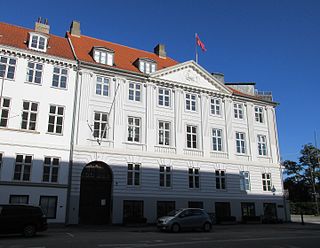
Amaliegade 40, formerly known as Toldbodbørsen, is a Neoclassical property located at the corner of Amaliegade and Esplanaden in the Frederiksstaden district of Copenhagen, Denmark. The shipping company D/S Norden was based in the building for more than one hundred years. It was listed in the Danish registry of protected buildings and places in 1918.

Gammel Strand 44 is a historic property overlooking Slotsholmens Kanal and Slotsholmen in the Old Town of Copenhagen, Denmark. The building was listed in the Danish registry of protected buildings and places in 1945. Notable former residents include ballet masters Antoine Bournonville and August Bournonville, physicist Hans Christian Ørsted and composer Friedrich Ludwig Æmilius Kunzen.

Vestergade 14 is a property located at the corner of Vestergade and Larsbjørnsstræde in the Latin Quarter of Copenhagen, Denmark. No. 14 and the neighbouring building at No. 16 were jointly listed on the Danish registry of protected buildings and places in 1939.
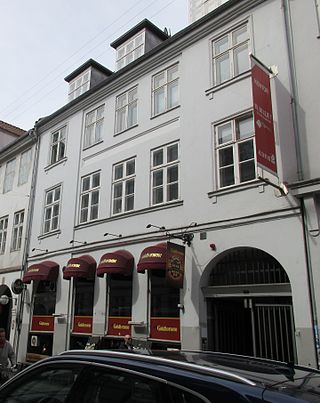
Vestergade 20 is a Neoclassical property in the Latin Quarter of Copenhagen, Denmark. The building was operated as a guesthouse under the name Vinkanden and the name was later changed to Dannebrog. The current building was constructed after the Copenhagen Fire of 1795. It housed J. E. Felumb's piano factory from 1882. It was listed on the Danish registry of protected buildings and places in 1939.

The Obel House is a Neoclassical property located at Vestergade 2 in the Latin Quarter of Copenhagen, Denmark. It was listed on the Danish registry of protected buildings and places in 1918.

Ny Vestergade 9 is an 18th-century building located across the street from the main entrance to the National Museum in central Copenhagen, Denmark. Former owners include court painter Hendrick Krock, printmaker Hans Qvist, Royal Armourer Christian Kyhl and wholesaler Jacob Stilling-Andersen. The building was listed in the Danish Registry of Protected Buildings and Places in 1932.
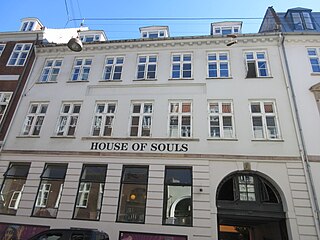
Vestergade 3 is a Neoclassical property in the Old Town of Copenhagen, Denmark. The building was constructed as part of the rebuilding of the city following the Copenhagen Fire of 1795. It was listed in the Danish registry of protected buildings and places in 1959. Notable former residents include the clergy Christian Bastholm and the painters Albert Küchler and Jørgen Roed.

Gammel Strand 42 is a historic property overlooking Slotsholmens Kanal and Slotsholmen in Copenhagen, Denmark. The building was constructed as part of the rebuilding of the city following the Copenhagen Fire of 1795. It listed on the Danish registry of protected buildings and places in 1945. Notable former residents include the surgeon Ludwig Lewin Jacobson, naval officer Lorentz Fjelderup Lassen, jurist F.C. Bornemand (1810–1861) and artists Harald Slott-Møller (1864–1937) and Agnes Slott-Møller.
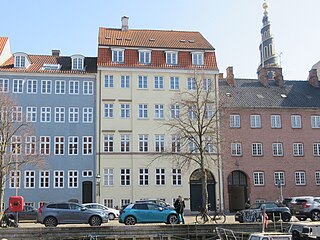
Overgaden Oven Vandet 50 is a residential property in the Christianshavn neighborhood of central Copenhagen, Denmark. It is one of three properties along Christianshavn Canal that were built by anchor smith Hans Caspersen and are now all known as the Hans Caspersen House, the others being Overgaden Neden Vandet 39 and Overgaden Neden Vandet 33. The building was completed in 1769 and listed on the Danish registry of protected buildings and places in 1945.

Vestergade 22 is a Neoclassical property in the Latin Quarter of Copenhagen, Denmark. The building is now part of the Politiken Hus complex. A commemorative plaque mounted on the wall of the gateway summarizes the history of the property, including the fact that Anders Sandøe Ørsted and his wife Sophie lived in the apartment on the first floor from 1805 to 1813. The building was listed on the Danish registry of protected buildings and places in 1959.

Gammel Strand 38 is a Neoclassical property overlooking Slotsholmen Canal in the Olt Town of Copenhagen, Denmark. The building was listed in the Danish registry of protected buildings and places in 1945. Krogs Fiskerestaurant, one of Copenhagen's oldest fish restaurants, occupies the ground floor of the building. Notable former residents include author Thomasine Gyllembourg and her son Johan Ludvig Heiberg, banker Gottlieb Abrahamson Gedalia and chocolate manufacturer Anthon Berg.

Nyhavn 55 is a just three-bays-wide, 18th-century canal house overlooking the Nyhavn Canal in central Copenhagen, Denmark. The building was listed in the Danish registry of protected buildings and places in 1918. The heritage listing comprises a half-timbered perpendicular side wing on its hear.

Admiralgade 23 is a Neoclassical property situated at the corner of Admiralgade and Dybensgade in central Copenhagen, Denmark. It was together with the adjacent building at Dybensgade 21 constructed for goldsmith Christian Nielsen Lindbach after the previous buildings at the site had been destroyed in the Copenhagen Fire of 1795. The two properties were merged into a single property in 1981. They were jointly listed in the Danish registry of protected buildings and places in 1945.

Gråbrødretorv 6 is a building at the corner of Gråbrødretorv and Niels Hemmingsens Gade in the Old Town of Copenhagen, Denmark. The oldest parts of the building date from the 1730s but it owes its current appearance to a reconstruction in 1818 and an adaptation undertaken by Valdemar Ingemann in 1881. It was listed in the Danish registry of protected buildings and places in 1945. Former residents include bishop Hans Lassen Martensen and businessman Jacob Heinrich Moresco.

Fiskebløderhuset is an 18th-century building situated at the corner of Gråbrødretorv and Niels Hemmingsens Gade in the Old Town of Copenhagen, Denmark. It was listed in the Danish registry of protected buildings and places in 1924. A fiskebløder was a special type of fishmonger, specializing in the soaking and selling of stockfish. Together with the adjacent buildings at Gråbrødretorv No. 3–9, the building is one of the best preserved examples of the so-called "fire houses" which were constructed as part of the rebuilding of the city following the Copenhagen Fire of 1728. A limestone tablet above the main entrance commemorates the fire.

Admiralgade 25/Laksegade 32 is a Neoclassical property situated at the corner of Admiralgade and Laksegade in central Copenhagen, Denmark. It was constructed for goldsmith Christian Nielsen Lindbach after his previous building on the site had been destroyed in the Copenhagen Fire of 1795. It was listed in the Danish registry of protected buildings and places in 1939.

Toldbodgade 5 is a 17th-century property situated in Toldbodgade, off Nyhavn in central Copenhagen, Denmark. It was listed in the Danish registry of protected buildings and places in 1977. The composer Carl Nielsen and the sculptor Anne Marie Carl-Nielsen resided in the apartment on the first floor from 1898 to 1906.

Gråbrødretorv 3 is an 18th-century townhouse situated on Gråbrødretorv in the Old Town of Copenhagen, Denmark. Together with the adjacent buildings Gråbrødretorv No. 1 and No. 5–9, it is one of the best examples of the so-called "fire houses" that were constructed throughout the city following the Copenhagen Fire of 1728. The building was listed on the Danish registry of protected buildings and places in 1926. It is a three-winged complex- consisting of a four-bay-wide, three-storey front wing and a four-bay-wide, three-storey rear wing, attached to each other via a staircase from 1816 along the east side of a central courtyard. A plaque on the facade commemorates that the poet Johan Herman Wessel (1742-1785) resided on the second floor when he wrote Jærlighed uden strømper in 1772. For the same reason, the building is also known as Wessel's House, although the poet never actually owned it but merely lived their as a lodger. Other notable former residents include the painter Nicolaus Wolff, master joiner Lasenius Kramp and art historian Harald Lundberg. In 1944, Langberg charged Elna Møller, a colleague from the National Museum of Denmark, with restoring the building.
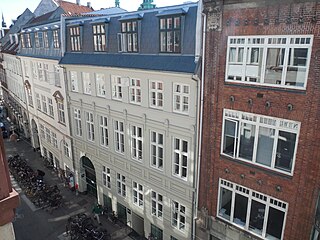
Vestergade 7 is a Neoclassical building complex situated close to Gammeltorv in the Old Town of Copenhagen, Denmark. It was constructed for royal building inspector Andreas Kirkerup as part of the building of the city following the Copenhagen Fire of 1795. The property was listed on the Danish registry of protected buildings and places in 1991. Notable former residents include the master builder Johan Boye Junge and archeologist Peter Oluf Brøndsted. The Danish Institute for Study Abroad (DIA) is now based in the building. The adjacent building at Vestergade 5 is also owned by the Danish Institute for Study Abroad.























